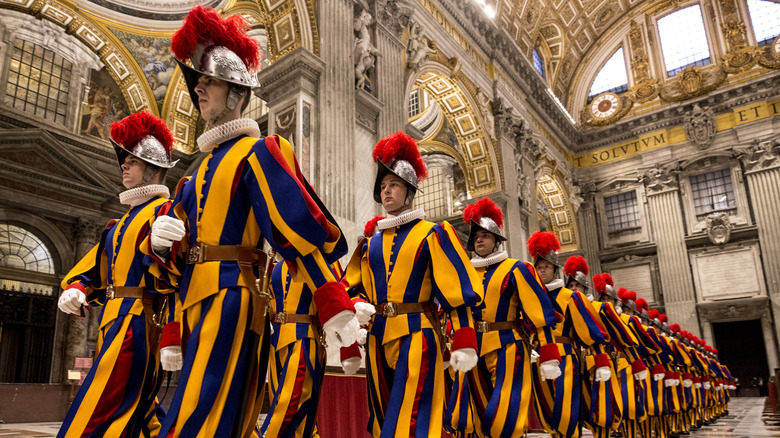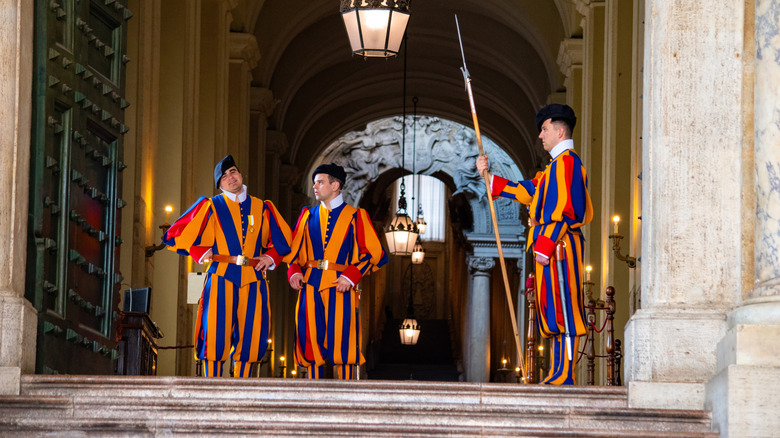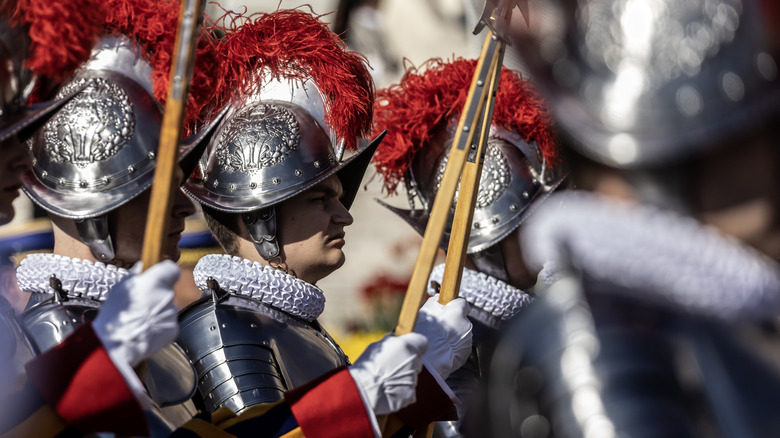The Meaning Of The Swiss Guards' Colorful Uniforms Explained
Every now and then, people get reminded that history consists of more than rising fast food prices, brain-rotting social media content, and this week's most ultra-super-important political entanglement in the history of ever. Take the 2025 death of Pope Francis, a widely beloved man who set out to embody Christian humility because the pope is "a pastor and disciple of Christ and not of a powerful person of this world," as the Vatican News cited Archbishop Diego Ravelli. After he died, folks once again relearned exactly what happens following a pope's death, right down to what happens to their body and the items with which they're buried. And then there's the Swiss Guard, the pope's personal bodyguard unit that some people might know by name, and which everyone can't help but notice on sight.
The Swiss Guard conjures all sorts of questions, like, "Why are they Swiss if they work at the Vatican?," and, "At which Hobby Lobby did they buy the materials for their parachute pants?" All jokes aside, there are real answers to such questions. The Swiss Guard, aka, "the world's smallest army" (135 people), has roots in the early 16th century, when Matthäus Schiner, a Swiss bishop, suggested creating a permanent, non-mercenary outfit to stay with the pope and protect him. This happened shortly before Pope Leo X stepped into power in 1513. Leo X was born Giovanni de' Medici of the Medici family, Florence's most powerful, wealthy, and politically influential bloodline. And the Swiss Guard's colors — red, yellow, and blue — are the Medici family colors.
Swiss Guard colors come from Medici family colors — according to the popular story
The Medici family of Florence, Italy is possibly the last thing you'd connect to Swiss Guard uniform colors. But such was the Medici's power, power that critics have long reviled as tyrannical and brutal. Still, the family's patronage of the arts granted us paintings like Botticelli's stupendous "Birth of Venus" and sculptures like Donatello's bronze David. Coming from humble roots in the 12th century, the Medici came to dominate Florentine banking and trade, particularly its critical wool industry. They brought with them a predictably complex net of rivalries with other houses, assassination attempts on their lives, some respected Medici family members like Lorenzo the Magnificent, and some reviled members like Cosimo de Medici. And Lorenzo's son, Giovanni di Lorenzo, even became Pope Leo X in 1513.
The Swiss Guard was inaugurated in 1506 during the reign of Leo X's predecessor, Pope Julius II. Like the Medici, Pope Julius II was a great patron of the arts and commissioned works from the likes of Michaelangelo and Raphael. We don't know who first suggested the Swiss Guard's colors, who designed the outfits, the precise order of events, or any of that. We do know that red, blue, and yellow are the Medici family colors, the Swiss Guard colors are the Medici family colors, and a Medici became pope seven years after the Swiss Guard's creation. But despite this being the official story, there's another apocryphal version that says only the Swiss Guard's red comes from the Medici, and blue and yellow are related to Pope Julius II's della Rovere family.
Alterations to Swiss Guard uniforms over time
As for the design of the Swiss Guard's uniform, it has roots in typical soldier's clothing dating to the early 16th-century from which the security unit originates — simple as that. Soldiers can wear their fun "Gala Uniforms," as they're called, or fit armor over them and swap out the hats for plumed helmets. And of course, there's halberds, rapiers, and daggers, which aren't clothing but are pretty cool.
The Swiss Guard's uniforms have changed over time, even if the uniform's colors haven't. The current uniforms are closer to the original Medici-era uniforms. By the time we get to Pope Pius X (pope from 1903 to 1914), the uniforms changed a bit and had different embroidery on the jacket. After Pius X's time as pope, the official Swiss Guard website tells us that guard commander Jules Repond (commander from 1910 to 1921) redrafted the design that stands to the present. He took inspiration from original Raphael-painted frescoes that depicted Swiss Guard uniforms. The hats were switched for the Basque-style caps worn today, and the vertical stripes on the uniforms are an intentional choice to "interrupt in a flowing movement the red vest and pants."
Swiss Guards, who must be single men aged 19 to 30 and be Catholic as well as Swiss, can keep their uniforms if they serve for five years or more. But even then, the garments must be returned either after death or before (one of the many rules they have to follow). All uniforms are considered permanent property of the Vatican.


